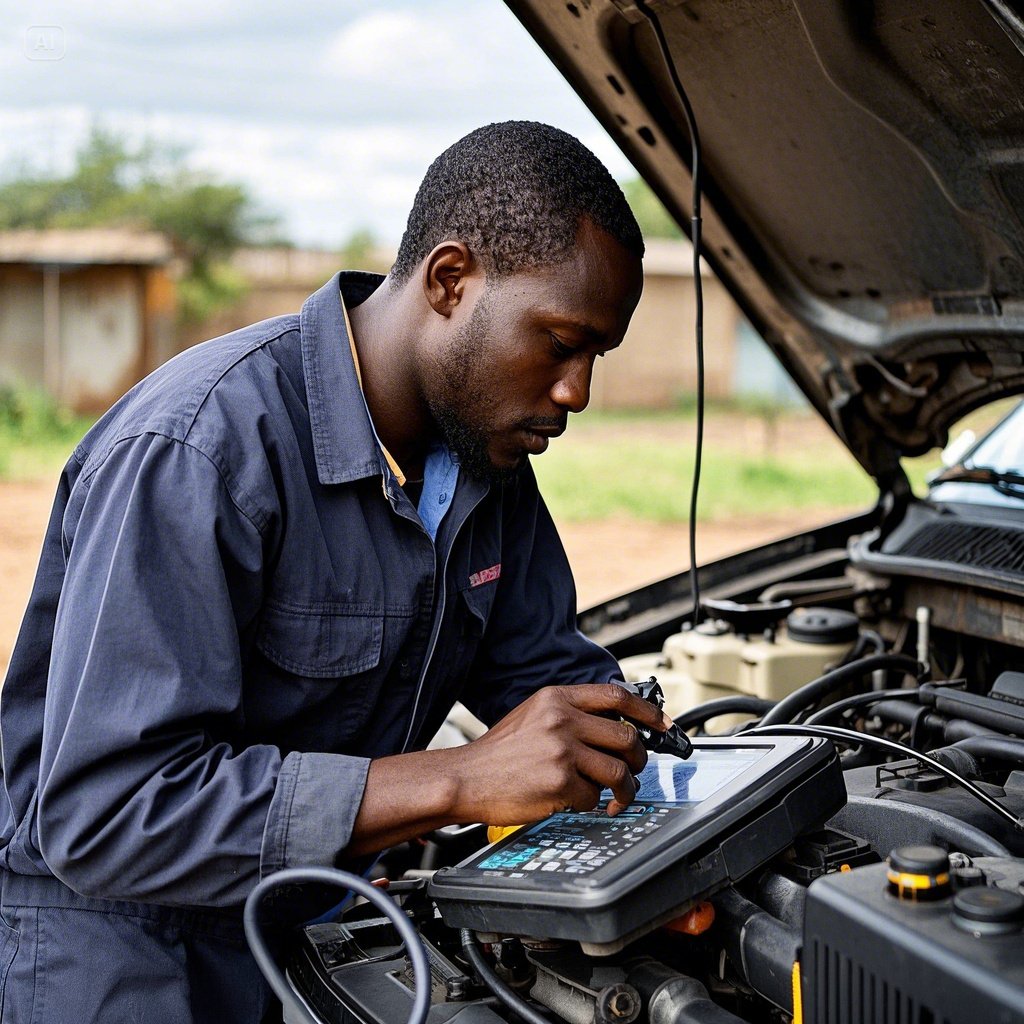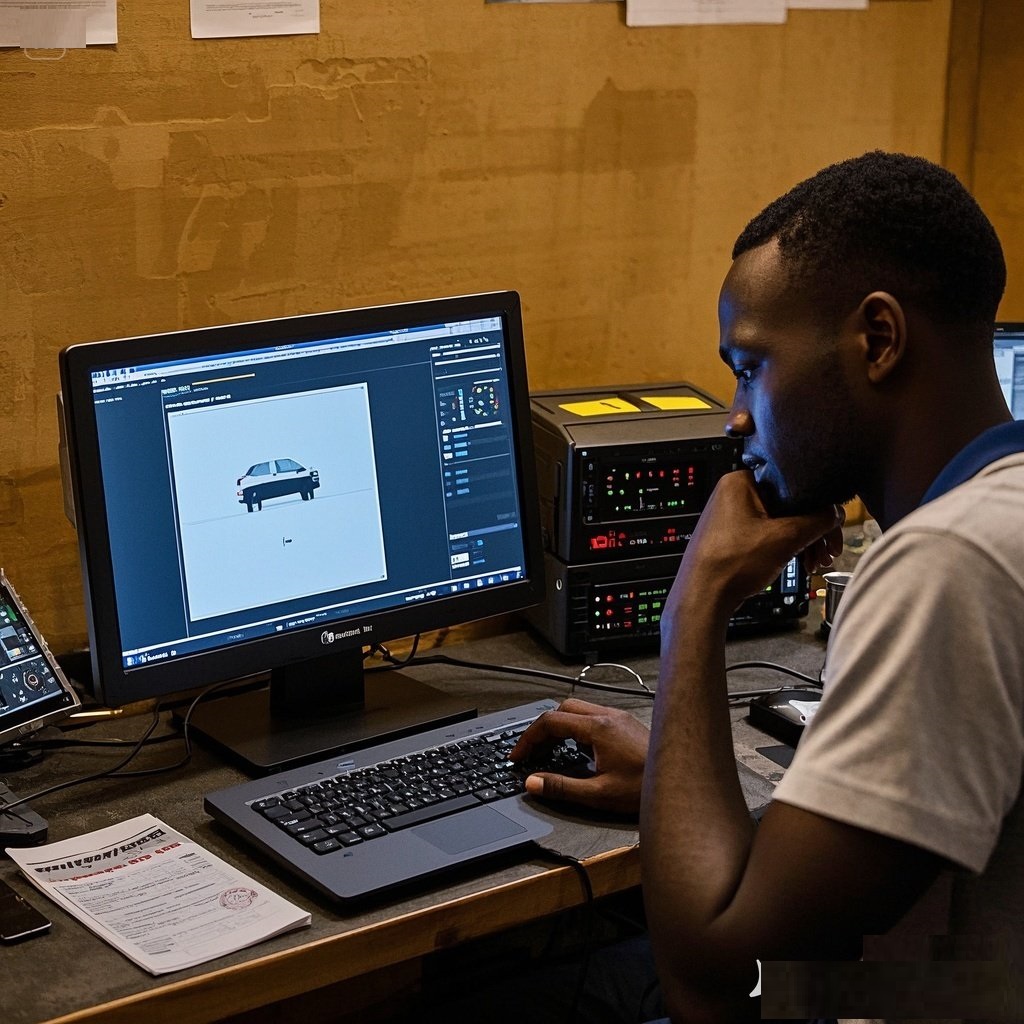Share this content:
Remember the days when fixing a car meant a set of spanners, a good wrench, and a bit of mechanical intuition? A sputtering engine could often be coaxed back to life by cleaning a carburetor or replacing a set of points. Those days, while fondly remembered, are firmly in the rearview mirror. The modern automobile is less a mechanical beast and more a rolling supercomputer on wheels.

𝐓𝐡𝐞 𝐃𝐢𝐠𝐢𝐭𝐚𝐥 𝐇𝐞𝐚𝐫𝐭 𝐨𝐟 𝐭𝐡𝐞 𝐌𝐨𝐝𝐞𝐫𝐧 𝐕𝐞𝐡𝐢𝐜𝐥𝐞
Walk around any car built in the last 15 years. Under the hood, you’ll find a symphony of electronics:
𝑻𝒉𝒆 𝑬𝒏𝒈𝒊𝒏𝒆 𝑪𝒐𝒏𝒕𝒓𝒐𝒍 𝑼𝒏𝒊𝒕 (𝑬𝑪𝑼): The brain of the engine, constantly adjusting fuel mixture, ignition timing, and emissions controls based on data from dozens of sensors.
𝑪𝑨𝑵 𝑩𝒖𝒔 𝑵𝒆𝒕𝒘𝒐𝒓𝒌𝒔: Instead of a tangled mess of individual wires for every function, modern cars use a Controller Area Network—a digital highway where modules for the engine, transmission, brakes, and infotainment all talk to each other.
𝑨 𝑷𝒍𝒆𝒕𝒉𝒐𝒓𝒂 𝒐𝒇 𝑺𝒆𝒏𝒔𝒐𝒓𝒔: Oxygen sensors, mass airflow sensors, wheel speed sensors, crankshaft position sensors—the list is endless. These are the car’s eyes and ears, feeding vital data to the ECUs.
𝑨𝒅𝒗𝒂𝒏𝒄𝒆𝒅 𝑫𝒓𝒊𝒗𝒆𝒓-𝑨𝒔𝒔𝒊𝒔𝒕𝒂𝒏𝒄𝒆 𝑺𝒚𝒔𝒕𝒆𝒎𝒔 (𝑨𝑫𝑨𝑺): Features like lane-keep assist, automatic emergency braking, and adaptive cruise control rely on cameras, radars, and ultrasonic sensors.
This technological leap means that a single fault code—like P0420 (Catalyst System Efficiency Below Threshold)—is rarely as simple as replacing a catalytic converter. It could be a faulty oxygen sensor, an exhaust leak, a problem with the fuel injection system, or a software glitch. The “guess-and-replace” method is not only ineffective but can be ruinously expensive.
𝐖𝐡𝐲 𝐘𝐨𝐮 𝐂𝐚𝐧’𝐭 𝐉𝐮𝐬𝐭 𝐋𝐞𝐚𝐫𝐧 𝐟𝐫𝐨𝐦 𝐚 𝐌𝐚𝐧𝐮𝐚𝐥 𝐀𝐧𝐲𝐦𝐨𝐫𝐞
You can read all the books and watch all the YouTube videos you want, but auto electrics and diagnostics are fundamentally practical disciplines. Theory gives you the map, but 𝐡𝐚𝐧𝐝𝐬-𝐨𝐧 𝐞𝐱𝐩𝐞𝐫𝐢𝐞𝐧𝐜𝐞 is the vehicle that gets you to the destination.
𝐇𝐞𝐫𝐞’𝐬 𝐰𝐡𝐲 𝐚 𝐩𝐫𝐚𝐜𝐭𝐢𝐜𝐚𝐥 𝐞𝐧𝐯𝐢𝐫𝐨𝐧𝐦𝐞𝐧𝐭 𝐢𝐬 𝐢𝐫𝐫𝐞𝐩𝐥𝐚𝐜𝐞𝐚𝐛𝐥𝐞
𝑰𝒏𝒕𝒆𝒓𝒂𝒄𝒕𝒊𝒏𝒈 𝒘𝒊𝒕𝒉 𝑹𝒆𝒂𝒍-𝑾𝒐𝒓𝒍𝒅 𝑭𝒂𝒖𝒍𝒕𝒔: Textbook problems are clean. Real-world problems are messy. A wiring diagram might show a perfect circuit, but in a real car, you’ll encounter corroded connectors, chafed wires hidden in looms, and intermittent faults caused by vibration or heat. These are puzzles you can only solve by doing.
𝑴𝒂𝒔𝒕𝒆𝒓𝒊𝒏𝒈 𝒕𝒉𝒆 𝑻𝒐𝒐𝒍𝒔 𝒐𝒇 𝒕𝒉𝒆 𝑻𝒓𝒂𝒅𝒆: The most important tool in modern diagnostics is the scan tool. Understanding how to use a quality OBD-II scanner, interpret live data streams, graph sensor readings, and perform bidirectional tests (like commanding a solenoid to activate) is a core skill. This isn’t something you can master by reading about it.
𝑫𝒆𝒗𝒆𝒍𝒐𝒑𝒊𝒏𝒈 𝒂 𝑫𝒊𝒂𝒈𝒏𝒐𝒔𝒕𝒊𝒄 𝑴𝒊𝒏𝒅𝒔𝒆𝒕: Diagnostics is the art of logical deduction. It’s about following a systematic process: from reading the fault code, to understanding the conditions that set it, to testing the relevant components and circuits, and finally, verifying the repair. This structured thinking is honed through repetition and guidance, not in isolation.
𝑩𝒓𝒊𝒅𝒈𝒊𝒏𝒈 𝒕𝒉𝒆 𝑺𝒌𝒊𝒍𝒍 𝑮𝒂𝒑: The Garage as a Classroom
For anyone looking to get into the automotive industry or simply to gain a valuable and marketable skill set, the question is: where do you start? How do you bridge the gap between theoretical knowledge and the practical, often messy, reality of fixing today’s cars?
The answer lies in finding a training ground that replicates the real world. An auto garage or a dedicated technical training centre that focuses on hands-on learning is the ideal modern classroom. It’s a place where you can:
𝘎𝘦𝘵 𝘺𝘰𝘶𝘳 𝘩𝘢𝘯𝘥𝘴 𝘰𝘯 𝘢𝘤𝘵𝘶𝘢𝘭 𝘷𝘦𝘩𝘪𝘤𝘭𝘦𝘴 𝘸𝘪𝘵𝘩 𝘳𝘦𝘢𝘭 𝘱𝘳𝘰𝘣𝘭𝘦𝘮𝘴.
– 𝘓𝘦𝘢𝘳𝘯 𝘵𝘰 𝘶𝘴𝘦 𝘮𝘶𝘭𝘵𝘪𝘮𝘦𝘵𝘦𝘳𝘴, 𝘰𝘴𝘤𝘪𝘭𝘭𝘰𝘴𝘤𝘰𝘱𝘦𝘴, 𝘢𝘯𝘥 𝘴𝘤𝘢𝘯 𝘵𝘰𝘰𝘭𝘴 𝘶𝘯𝘥𝘦𝘳 𝘦𝘹𝘱𝘦𝘳𝘵 𝘴𝘶𝘱𝘦𝘳𝘷𝘪𝘴𝘪𝘰𝘯.
– 𝘗𝘳𝘢𝘤𝘵𝘪𝘤𝘦 𝘳𝘦𝘢𝘥𝘪𝘯𝘨 𝘸𝘪𝘳𝘪𝘯𝘨 𝘥𝘪𝘢𝘨𝘳𝘢𝘮𝘴 𝘢𝘯𝘥 𝘱𝘩𝘺𝘴𝘪𝘤𝘢𝘭𝘭𝘺 𝘵𝘳𝘢𝘤𝘪𝘯𝘨 𝘤𝘪𝘳𝘤𝘶𝘪𝘵𝘴.
– 𝘜𝘯𝘥𝘦𝘳𝘴𝘵𝘢𝘯𝘥 𝘵𝘩𝘦 𝘪𝘯𝘵𝘦𝘳𝘱𝘭𝘢𝘺 𝘣𝘦𝘵𝘸𝘦𝘦𝘯 𝘮𝘦𝘤𝘩𝘢𝘯𝘪𝘤𝘢𝘭 𝘴𝘺𝘴𝘵𝘦𝘮𝘴 𝘢𝘯𝘥 𝘵𝘩𝘦𝘪𝘳 𝘦𝘭𝘦𝘤𝘵𝘳𝘰𝘯𝘪𝘤 𝘤𝘰𝘯𝘵𝘳𝘰𝘭𝘴.
This environment transforms abstract concepts into tangible skills. It’s the difference between knowing what a CAN Bus is and knowing how to diagnose a CAN Bus communication failure when the car won’t start.
𝐘𝐨𝐮𝐫 𝐋𝐚𝐮𝐧𝐜𝐡𝐩𝐚𝐝 𝐢𝐧𝐭𝐨 𝐭𝐡𝐞 𝐖𝐨𝐫𝐥𝐝 𝐨𝐟 𝐀𝐮𝐭𝐨 𝐓𝐞𝐜𝐡: 𝐊𝐞𝐧𝐯𝐢𝐬𝐢𝐨𝐧 𝐓𝐞𝐜𝐡𝐧𝐢𝐤𝐬
In Nairobi, for those seeking this crucial practical education, one centre stands out for its commitment to hands-on, accessible training: Kenvision Techniks, based in Kahawa Sukari, Nairobi, Kenya.
Kenvision Techniks has carved a niche by understanding the very skill gap we’ve been discussing. They have built their philosophy around the principle that the best way to learn is by doing. Their training facility is designed not as a lecture hall, but as a working garage environment, providing the perfect bridge between theory and practice.
𝐖𝐡𝐚𝐭 𝐦𝐚𝐤𝐞𝐬 𝐊𝐞𝐧𝐯𝐢𝐬𝐢𝐨𝐧 𝐚𝐧 𝐞𝐱𝐜𝐞𝐩𝐭𝐢𝐨𝐧𝐚𝐥 𝐜𝐡𝐨𝐢𝐜𝐞 𝐟𝐨𝐫 𝐛𝐮𝐝𝐝𝐢𝐧𝐠 𝐚𝐮𝐭𝐨 𝐞𝐥𝐞𝐜𝐭𝐫𝐢𝐜𝐢𝐚𝐧𝐬 𝐚𝐧𝐝 𝐝𝐢𝐚𝐠𝐧𝐨𝐬𝐭𝐢𝐜𝐢𝐚𝐧𝐬?
𝑷𝒓𝒂𝒄𝒕𝒊𝒄𝒂𝒍-𝑭𝒊𝒓𝒔𝒕 𝑪𝒖𝒓𝒓𝒊𝒄𝒖𝒍𝒖𝒎: Their courses, particularly in auto electrics and electronics, are heavily skewed towards hands-on sessions. You won’t just be told how an alternator works; you’ll diagnose faulty ones, test their output, and learn the patterns of failure on a real vehicle.
𝑨𝒄𝒄𝒆𝒔𝒔𝒊𝒃𝒊𝒍𝒊𝒕𝒚 𝒇𝒐𝒓 𝑨𝒍𝒍: A key and commendable aspect of Kenvision’s approach is their openness to even those who have had no prior experience in automotive skills. They start from the very basics, ensuring that complete beginners are not left behind. They demystify electronics, breaking down complex topics into digestible, practical lessons. Whether you’re a fresh high school graduate, a career-changer, or a car enthusiast, they provide a structured path to competence.
𝑰𝒏𝒅𝒖𝒔𝒕𝒓𝒚-𝑹𝒆𝒍𝒆𝒗𝒂𝒏𝒕 𝑺𝒌𝒊𝒍𝒍𝒔: The training at Kenvision is tailored to the vehicles on Kenyan roads. You learn to diagnose and fix the problems that are most common in the local context, making the skills you acquire immediately relevant and marketable.
Expert Guidance: Learning in a garage environment under the watchful eye of experienced instructors accelerates the learning curve immensely. They can point out the nuances, the common pitfalls, and the “tricks of the trade” that take years to learn independently.
For anyone in Nairobi—or Kenya at large—looking to future-proof their career or hobby, Kenvision Techniks in Kahawa Sukari represents a direct and effective route into the vital world of automotive electronics and diagnostics.
𝐓𝐡𝐞 𝐑𝐨𝐚𝐝 𝐀𝐡𝐞𝐚𝐝
The automotive industry is not slowing down. The transition to electric and hybrid vehicles is already underway, making electrical and diagnostic skills even more critical. The ability to work safely on high-voltage systems and diagnose complex electronic networks will define the next generation of automotive technicians.
Investing in these skills now is not just about keeping up; it’s about getting ahead. It’s about moving from being a passive driver to an empowered owner, from a hobbyist to a skilled technician, from a job-seeker to a solution-provider.
So, shift your mindset. Embrace the digital nature of the modern car. Pick up a multimeter, familiarize yourself with a scan tool, and most importantly, find a practical, hands-on environment where you can learn. It’s time to plug into the future of automotive repair, and that journey begins with understanding the electrons under the hood.
𝐍𝐞𝐞𝐝 𝐭𝐨 𝐭𝐫𝐚𝐢𝐧 𝐰𝐢𝐭𝐡 𝐮𝐬? Click on the following link to access our forthcoming trainings in this skill:
YR 2025: Auto Engine Diagnosis Skills Trainings
